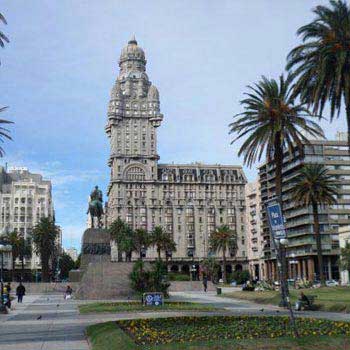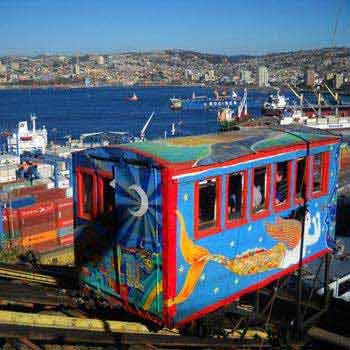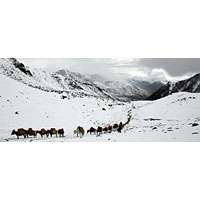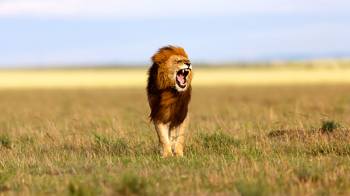24 Nights / 25 Days

Experience 4 countries travelling from Cape Town to Zimbabwe. See the highlights of Namibia including Fish River Canyon, dunes of Sossusvlei, Etosha & Himba tribe. Traverse Botswana from Okavango to Chobe, for water & land game viewing. Finish at the mighty Victoria Falls. Travel by rugged overland truck with dome tents, camping equipment & activities included. Regular departures with group size 4 to 18.
HIGHLIGHTS
• Cape Town • Cedarberg Mountains • Orange River • Fish River Canyon
• Sossusvlei • Etosha Game Reserve • Windhoek • Okavango Delta
• Chobe Game Reserve • Victoria Falls
You will be met at Cape Town Airport and transferred to your hotel in this beautiful city, within sight of Table Mountain.
Check in and relax in your magnificent surroundings.
Today is free for independent sightseeing in Cape Town.
We recommend you purchase a day pass onboard the convenient Hop-Off Bus, which stops at all Cape Town’s key sights and beaches. The "Red Route" bus stops at the Table Mountain base station, where you can buy a ticket to ascend by cable car and enjoy one of the world’s most famous views. Continue to Camps Bay beach and the many attractions of the Victoria & Alfred Waterfront.
Today we recommend an optional full day tour to the beautiful Cape of Good Hope Nature Reserve, where you may see baboons, ostrich and perhaps even dolphins or whales in season (July/November).
Your tour travels through Hout Bay and along spectacular Chapman’s Peak Drive to the Cape Point peninsula, returning via Simons Town, Fish Hoek, Constantia and Kirstenbosch Gardens. This is a scenic tour of the whole Cape Peninsula, with the optional opportunity of visiting the penguin colony at Boulders Beach.
At leisure to relax and explore the 'Mother City' of Cape Town.
Many optional activities are available in this beautiful city. You can visit Robben Island where Nelson Mandela was imprisoned (advance booking essential in season), Kirstenbosch Gardens and the vibrant Victoria & Alfred Waterfront.
Golf and deep sea game fishing are available, or you can or simply relax on Camps Bay beach – the choice is yours.
This morning you will be collected from your hotel and transferred to the departure point of your group adventure tour, travelling in a rugged 4x4 overland truck.
Leaving Cape Town we make a last photo stop to look back at Table Mountain, before we travel across the Piekenierskloof Pass on our way to the Cederberg Mountains. No road trip is complete without a stop at a traditional Padstal - one of the small farm stalls that dot the byways of South Africa and offer a variety of homemade treats and bakes. The Cederberg region not only boasts spectacular mountains and orange farms, but it is also the home of the Rooibos tea bush. Indigenous to the mountain slopes of the Cederberg, this herbal beverage has earned an international reputation as a healthy and refreshing alternative to regular tea.
A wine tasting and traditional dinner offer an opportunity for us to get acquainted while enjoying some South African hospitality.
A dome tent & camping mattress are provided, but you need to bring your own sleeping bag, pillow & towel. You will be expected to erect your own tent, which is easy to master. All meals whilst on tour are included and are prepared & served from the overland vehicle except for specified optional dinners in cities. Alcohol is not included. Facilities at campsites generally include shared ablutions & hot shower, except where bush camping is specified. Truck lockers are 30 x 80cm, so please use soft bags that will fit (but there is no weight restriction).
Average group size is 14 people (with minimum of 4 and maximum of 18). On camping tours the average age is 30 years, with a range from 18 to 55 although this does vary by tour. Teens aged 16 to 18 years are on request and must travel with an adult.
Today we travel through the Northern Cape to Namaqualand, which presents us with our first experience of the desert vistas that will accompany us in the days ahead.
We continue our journey north and after a short stop for supplies in the small town of Springbok, best known for its diamonds, copper and spring flowers, we continue to our camp on the banks of the Orange River, which forms the natural border between South Africa and Namibia.
If you are fortunate enough to be travelling in the spring months (July to September) you may encounter the wild flowers that have made this region famous. No matter the time of year though, the strange desert vistas offer a unique backdrop to today's travels.
While the Orange River was named after the Dutch royal house, in recent times it has been referred to by its original name of Gariep, which simply means “river” in the indigenous KhoeKhoe language.
Beginning its journey in the mountains of Lesotho the Orange River is the longest river in South Africa and offers a unique contrast to the desert landscapes along its banks. The best way to experience the river is by getting out on the water and this morning we have the opportunity to join an optional canoe trip on the river.
Later this morning we cross the border into Namibia and travel onwards to the Fish River Canyon, one of the largest in the world. This afternoon we take a walk along the rim of the canyon and end our day with a memorable sunset on the canyon edge.
Note: Hot water showers are not always available at this campsite.
Every overland journey has some long travelling days and today is one of those as we venture deeper into the Namib Desert, the oldest desert on earth where some of the highest sand dunes in the world stand towering over the white desert plains. These great mountains of sand are a monument to the extreme forces of nature, with fog supplying life giving moisture for the survival of its plants and animals.
Our destination is the dune fields that cover the western reaches of the desert. Long dusty roads and sparsely populated farmlands offer us an insight into the vastness of rural Namibia. From the grasslands in the east to the red dunes of the west the slowly changing landscapes represents the many faces of this desert country. Tonight we camp on the doorstep of the dune fields and fall asleep to the unique calls of the elusive barking gecko.
Watching the sunrise over the red dunes is an iconic highlight of any trip to Namibia and this morning we rise before the sun to capture this magnificent moment. A brisk climb up Dune 45 offers us the perfect vantage point to marvel at the changing colours of the desert sunrise.
Once satisfied we descend this famous dune and enjoy a hearty breakfast before catching a 4×4 transfer into Sossusvlei, where we spend time on foot visiting the pans at Sossusvlei and Deadvlei.
A last stop at the Sesriem Canyon will end our visit to the dune fields, but our day in the desert continues this afternoon as we join a local expert for an educational desert excursion. Tonight we empty the red sand from our shoes and spend the night under the magnificent desert stars, knowing that we have spent a full-day enjoying the wonders of this harsh land.
Today we continue west and make our way to the coastal town of Swakopmund, where adventure and a dose of civilisation await.
Reluctantly we leave the Namib behind and after a stop to mark our crossing of the Tropic of Capricorn, we continue to the Atlantic coastline. We make a brief stop at the Walvis Bay lagoon, where we hope to catch a glimpse of the flamingos that feed in the shallows. Arriving in Swakopmund we will have the opportunity to book some of the many optional adventures on offer.
Swakopmund is situated on the Atlantic Coast where the cold Benguela Current sweeps up from Antarctica, releasing no moisture into the prevailingly onshore winds – hence the very low rainfall and desert conditions. Fog is common along the coast in the early mornings and late afternoons and this is what gives life to the desert-adapted flora and fauna of the region. The cold current is also highly oxygenated, causing it to teem with marine life. We enjoy an optional dinner out at a local restaurant tonight.
Dinner is not included this evening, as there is the option of dinner out.
At leisure to relax and explore the beach resort of Swakopmund.
While for many it is the adrenaline fuelled adventures that will grab their attention, Swakopmund offers all that and more. Take the opportunity today to explore the town at your leisure, as there are a number of attractions for every taste, including optional quad biking, sandboarding, sky diving or dolphin cruise.
Not to be missed is the selection of famed coffee shops and bakeries that offer a delightful range of German inspired treats. Swakopmund offers all the conveniences of a small city and is the perfect launching pad for the journey through the northern reaches of this land.
Lunch & dinner are not included today, as there are many restaurants in Swakopmund for you to enjoy.
This morning we travel a section of the famous Skeleton Coast road. We pass the salt works and head north for a photo opportunity in the colourful town of Wlotskasbaken. Lichens are one of the most fascinating examples of symbiosis in nature, as algae and fungi unite to form the lichen and live inseparably as one organism.
We will have the opportunity to view these fascinating desert inhabitants before turning east towards Spitzkoppe. These massive granite formations tower 700 metres above the desert plains below and the presence of rock art indicates their significance to the San people who lived here many years ago. We will enjoy a late afternoon walk with a local guide and have the opportunity to view some examples of the San’s rock art.
We continue north this morning and on our way we will visit a project that will introduce us to the Himba people of northern Namibia.
The semi-nomadic Himba tribe are extremely susceptible to Western influences and have lost a large portion of their land to farmers, engineers and miners. Many were also displaced during the wars that raged between Namibia and Angola. The dwindling number of pastoralists that still exist in their natural environment are protected as far as possible by creating a “buffer zone”, or an “educational tribe” where tourists who would like to get a better understanding of the lifestyle of the Himba and their traditions, can do so without interfering with those still living in their natural environment.
Visiting the Himba tribe can be a controversial topic that gets discussed around the camp fire, however not so much if the reason for visiting this particular tribe is understood beforehand. The income that this specific tribe generates from the visits goes towards the education of orphaned Himba children and assists the tribe in giving them a chance to learn about their own culture and heritage. There is a market at the end of your visit, this is a way for the women to establish a small income, used for their own private expenses, and it is up to you whether you’d like to purchase anything or not.
We continue to our camp for the night and prepare for two magical days of game viewing in Etosha National Park.
Rising early this morning we make the short drive to the Etosha National Park, the venue for some of the most unique game viewing experiences in Africa.
Etosha owes its unique landscape to a vast shallow depression – the Etosha Pan. During the dry season it becomes an expanse of white cracked mud, shimmering with mirages and spiralling dust devils, with its open pans offering magnificent game viewing. Etosha is home to over a hundred different species of mammals, including cheetah, leopard, lion, elephant, rhino, giraffe, zebra and wildebeest.
Today we have a full-day to explore the edges of Etosha Pan in search of the abundant wildlife that occurs in the park. Our truck offers us an elevated platform and we will spend some time at the many waterholes dotted throughout the park. Evenings in Etosha are best spent wrapped up warmly at the floodlit waterholes at the camps. Those who wish to partake in an optional night drive may do so tonight.
Our second day in Etosha National Park allows another full day to continue our exploration of the park - one of the largest wildlife conservation areas in Africa, surrounding an enormous salt pan that is the size of the Netherlands.
No day on safari is ever the same and the suspense before that special sighting is the motivation that keeps our eyes wide open. The vast Etosha Pan offers magnificent game viewing opportunities including springbok, oryx and black-faced impala. A series of waterholes throughout the park and at your rest camp guarantees rewarding game viewing, with Etosha being renowned for its vast arrays of plains game and its “great cats” which are more easily seen on the open pans.
Etosha is also a bird watchers paradise, with hundreds of recorded bird species and many migrants during the summer months. In the evening, enjoy the balmy weather and pristine stars of the Southern Sky and Milky Way, as you have never seen them before – including the spectacular Southern Cross.
Tonight a second opportunity presents for those who wish to do an optional night drive, while the floodlit waterholes ensure that our game viewing continues deep into the night.
A last early morning and short game drive to the gate sees us wrap up our visit to Etosha and take aim for Windhoek, the capital city of Namibia.
We make a brief stop at the craft markets of Okahandja, before arriving in Windhoek in the afternoon. We take a short walk through the city centre and have the opportunity to view some of its better known landmarks.
Tonight we have the option to dine together at Windhoek’s most famous eatery, Joe’s Beer House, which has gained a reputation for its venison dishes and quirky atmosphere.
Dinner is not included this evening, as there is the option of dining out.
Today we travel east and make our way to neighbouring Botswana and the Kalahari Desert.
Starkly different to the Namib Desert, after which Namibia is named, the Kalahari is no less dramatic and covers over 900,000 square kilometres. The San people have long been associated with this harsh environment and tonight we enjoy a dance evening that provides an insight into their culture of song, dance and story-telling.
The San Bushmen have existed in some of the harshest conditions for thousands of years and this morning you will have the opportunity of joining an optional walk with San guides to learn how they embrace the environment to survive.
This afternoon we journey to Maun - the gateway to the Okavango Delta. Your guide will brief you on what to pack for our Okavango Delta excursion (a small daypack or overnight bag will be needed, due to space restrictions on our transfers to and from camp).
Today we embark on our Okavango Delta excursion.
This unique and unusual ecosystem sees the annual flood waters of the Okavango River fan out into the sands of the Kalahari Basin – never finding the sea, but instead forming a great inland delta whose waters are absorbed by the desert.. The seasonality of the flood waters lends the Delta its ever changing character. While water levels may fluctuate the tranquillity of this wilderness area remains constant.
Comprising 6,000 square miles of crystal clear channels, serene lagoons and a myriad of islands, the Okavango Delta forms a natural oasis that sustains a vast variety of wildlife and birds of all descriptions. The waters are at their height from July to October, forming an amazing wetlands ecosystem that is one of the greatest natural wonders of the world.
A full day is set aside to enjoy the activities on offer in the Okavango Delta.
While the programme of activities is flexible to accommodate the seasonal changes, you will have the opportunity to enjoy amongst other activities traditional mokoro rides and natures walks. The Okavango Delta is not only a natural wonder, but represents one of the last great wilderness areas in the world today.
Leaving the Okavango Delta behind us this morning, we make our way to the Botswana border and re-enter Namibia.
As we transit through the Caprivi, much of our day is spent travelling through game parks and there is always the possibility of a lucky sighting.
We overnight a short distance from the Botswana border as we prepare for an exciting day of activities in Chobe National Park tomorrow.
We enjoy our breakfast in Namibia this morning, before re-entering Botswana and travelling to our camp on the banks of the Chobe River.
Lunch will be served from the truck and the afternoon is set aside for exploring Chobe National Park, uniquely situated at the confluence of the Zambezi and Chobe Rivers where four African countries meet – Botswana, Namibia, Zimbabwe and Zambia. This is Botswana’s premier wildlife reserve, surrounded by vast endless landscapes, open plains, baobab trees and the abundant river-based wildlife of Chobe.
We begin our exploration in 4×4 vehicles, which allows us an up close and personal experience with the many elephants that frequent the river. In the late afternoon a special highlight is a game viewing sunset cruise on the Chobe River.
With the memories of our wildlife encounters firmly etched in our minds, we cross the border into Zimbabwe this morning and travel the short distance to Victoria Falls.
We enter Victoria Falls National Park and view the magnificent “Mosi-oa Tunya” - Smoke That Thunders - first discovered by Dr. David Livingstone and still one of the greatest natural wonders of the world. The flow of water over the falls is greatest from February to June following the summer rains, but they are a magnificent sight at any time of year.
While much of today is dedicated to viewing the mighty Zambezi River as it drops into the Batoka Gorge below, the bustling adventure town of Victoria Falls also offers a range of optional activities for those wanting a dose of adrenaline in the afternoon. For the more relaxed traveller there are craft markets and coffee shops on offer as well. Tonight we enjoy an optional dinner out.
Dinner is not included at Victoria Falls, as there is the option of dining out.
Today is free to relax at Victoria Falls after the end of your tour.
Many optional activities are available including a Sunset Cruise on the Zambezi River where you may see hippos, crocodiles and abundant bird life; a helicopter flight over the falls and an elephant interaction.
Transfer to Victoria Falls Airport for your flight home.
| No of pax | Age Limit | Price per pax (Rs) |
|---|---|---|
| Adult | Above 12 years | $ 2900 / Adult |
Our company base is in Ancient Olympia the most historical place in Greece.My name is Theodoros Mamousis. Read More...
2,50,850 PP
 11D/10N
11D/10N
 13D/12N
13D/12N
 15D/14N
15D/14N
Best Of India: Golden Triangle & Kerala ..
New Delhi - Agra - Jaipur - Kovalam - Kochi - Alleppey
 13D/12N
13D/12N
 11D/10N
11D/10N
 14D/13N
14D/13N
 10D/9N
10D/9N
 13D/12N
13D/12N
 11D/10N
11D/10N
 25D/24N
25D/24N
Chennai - Mahabalipuram - Thanjavur - Kumbakonam - Tiruchirappalli - Madurai - Rame..
 25D/24N
25D/24N
 25D/24N
25D/24N
 25D/24N
25D/24N
 25D/24N
25D/24N
Mumbai - Nashik - Varanasi - Bijapur - Badami - Hampi - Hassan - Mysore - Mettupala..
 25D/24N
25D/24N
Mumbai - Nashik - Varanasi - Bijapur - Badami - Hampi - Hassan - Mysore - Mettupala..
 25D/24N
25D/24N
 25D/24N
25D/24N
Rejuvenation and Meditation Tour
Chennai - Mahabalipuram - Thanjavur - Trichy - Madurai - Rameshwaram - Kovalam
 25D/24N
25D/24N
 13D/12N
13D/12N
Spectacular South Africa With Kruger 13 ..
Limpopo - Cape Town - Johannesburg
 14D/13N
14D/13N
 6D/5N
6D/5N
 9D/8N
9D/8N
 11D/10N
11D/10N
South Africa 10 Nights - 11 Days Package
Garden Route - Cape Town - Johannesburg - George
 9D/8N
9D/8N
 15D/14N
15D/14N
 7D/6N
7D/6N
 14D/13N
14D/13N
Cape Town - Sinai Peninsula - Victoria Falls - Masai Mara - Arusha - Western Cape -..